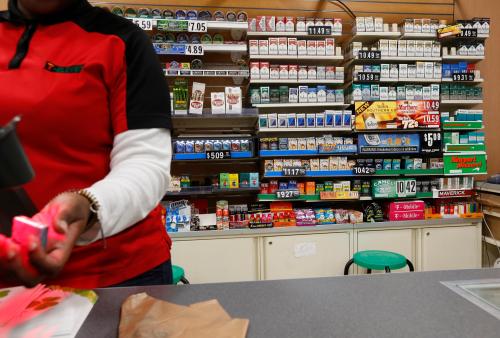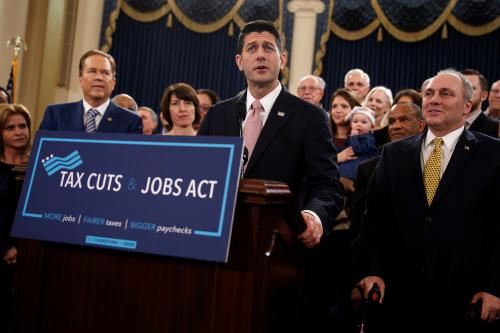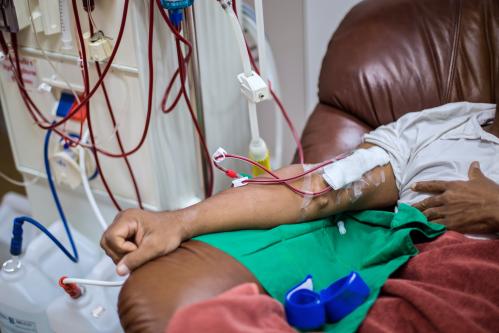The government taxes beer, wine and spirits for a couple of reasons: (1) To raise revenue and (2) to offset the costs—economists call them “externalities”—that drinking imposes on society, such as accidents caused by drunk drivers or higher rates of crime.
The Senate tax reform bill introduced in early November includes deep cuts to federal excise taxes on alcohol producers—cuts will lead to more drinking and thus more alcohol-related deaths and violence.
Based on empirical studies measuring the link between alcohol taxes and alcohol-related injuries, I estimate the legislation will cause between 280 and 660 additional motor vehicle deaths a year and approximately 1,550 total alcohol-related deaths annually from all causes. (Read more here on how I arrived at this estimate.) Of course, the economic costs associated with alcohol extend well beyond deaths and include alcohol-related injuries, crime, domestic violence, alcohol-related disease, and associated costs to families and local law-enforcement and health-providers.
Despite being billed as tax cuts for “Craft Beverage” producers, the benefits will accrue to producers across the board, providing windfalls to the large oligopolies that dominate the beer, wine, and spirits industry—and to foreign producers. And the fine print of the tax cuts will create compliance nightmares, particularly for our Customs and Border Patrol.
Based on economic evidence of the negative externalities imposed by alcohol, the total local, state and federal tax on alcohol should be roughly four times higher than it is now, and certainly not lower. Even modest increases in the rate, and indexing the tax for inflation, would be improvements relative to current law. Rather than establishing new tax preferences based on production levels and volumes—which are hard to enforce, complicated, and economically unjustified—a better approach is to harmonize the tax rate across beverages based on alcohol content and eliminate the special preferences and credits that currently exist based on production volume or use of flavors or additives.
Tax Revenues Under the Legislation
The so-called “Craft Beverage” legislation inserted into the Senate Tax Bill would cut federal alcohol excise tax revenues by 16 percent by 2019. These cuts are achieved mostly by lowering rates on the first several thousand (or several million) units of wine, beer, and spirits produced or imported into the U.S. The tax rates on distilled spirits, for example, is reduced by 80 percent on the first 100,000 gallons produced or imported.
The current tax rates, which have not been increased since 1991 and are not indexed for inflation, have eroded by an average of 36 percent in real terms time since 1991 (using the PCE deflator). The following chart shows historical alcohol excise tax revenues in inflation-adjusted terms and the consequences of the proposed new cuts to alcohol taxes in 2018 and 2019. The legislation would send alcohol taxes down by 16 percent to their lowest level since at least 1950.
When adjusted for changes in prices generally (using the PCE deflator), federal excise taxes on beer, wine, and spirits have decreased by a substantial 71 percent, 66 percent, and 80 percent, respectively, since 1950.
Not only do these tax cuts add to the deficit, they increase the negative social costs associated with alcohol use.
What’s the right tax rate on alcohol? Externalities associated with alcohol consumption
Negative externalities associated with alcohol consumption provide an important justification for imposing an excise tax. The externalities of alcohol primarily stem from three sources: motor vehicle accidents, violence (including domestic abuse), and non-actuarially fair medical and pension costs (less offsets from reduced lifespans).
For instance, Cook and Durrance (2011) find that the 1991 alcohol excise tax reduced injury deaths by 4.7 percent or almost 7,000 deaths in 1991. Chaloupka et al. (1993) conclude that higher beer excise taxes are among the most effective means for reducing drinking and driving and that a policy adjusting the Federal beer tax for the inflation rate since 1951 would have reduced total fatalities by 11.5 percent between 1982 and 1988. Ruhm (1996) estimates that raising the beer tax by 78 percent in 1988 (to the level that prevailed in 1975) would have resulted in a 7 to 8 percent reduction in highway fatalities, saving 3,300 to 3,700 lives annually.
Other studies show similar reductions in alcohol-related disease, homicide, domestic violence, other crime, and suicide deaths (Chaloupka et al. 2002). Based on these studies, a 16 percent decline in alcohol excise taxes is estimated to result in between 281 and 659 additional motor vehicle fatalities in 2016 (relative to a baseline of 37,461 deaths) and 1,550 additional alcohol-related deaths (again, see the note here for more on the calculation).
The total cost of the externality associated with alcohol is substantially higher than the current set of federal and state tax rates (Manning 1989, 1991; Grossman, et al. 1993; Parry et al. 2009). Manning puts externality at $0.48/oz in 1986 or about $58 per proof gallon in 2015; Parry et al. (2009) estimate the externality at $68 per alcohol gallon in 2000 or about $45 per proof gallon in 2015 (about $2.50 per six pack). By comparison, under current law, the federal tax per proof-gallon is $13.50 for distilled spirits, $4.84 for beer, and $4.27 for most wine. According to a survey by the Congressional Research Service, current combined taxes on alcohol (including federal, state, and local taxes) are roughly one-quarter of the external costs of alcohol consumption (Lowry 2014).
Moreover, increases in tax rates are likely to be an effective and efficient way to reduce the negative externalities of alcohol consumption because they affect all alcohol consumers. The available evidence suggests that consumers respond to higher alcohol prices by reducing consumption (Roodman 2015; Lowry 2014). Studies generally have found that the absolute value of the price demand elasticity for alcohol is between 0.5 to 1.1, which means that a 1 percent increase in the price of alcohol reduces consumption by between 0.5 and 1.1 percent. (The elasticity is estimated to be at the lower end of the range for beer but higher for wine and spirits.) That suggests the historical erosion in the effective excise tax rate has contributed to higher alcohol consumption. Moreover, measures of costly behaviors, like the symptoms of alcohol dependence and abuse, appear to be even higher in the literature, suggesting that alcohol taxes deter or reduce the social costs of problematic drinking.
In summary, the empirical literature reviewing changes in state tax law and the 1991 federal tax increase demonstrate that alcohol excise taxes are an effective means to reduce alcohol-related fatalities, injuries, and crime.
In summary, the empirical literature reviewing changes in state tax law and the 1991 federal tax increase demonstrate that alcohol excise taxes are an effective means to reduce alcohol-related fatalities, injuries, and crime. Moreover, a consideration of the externalities associated with alcohol use suggests that Federal excise taxes on alcohol are too low and should be indexed to inflation at a higher level.
Problems with Complexity, Compliance, and Enforcement
The legislation—particularly the substantially reduced tax rates based on production volume—will exacerbate existing problems and create new ones.
Alcohol excise tax rates are already complex. Tax rates on some alcohol products are based explicitly on the alcohol content of the product while rates on other products are not. Translating the tax rates to a proof gallon unit of analysis for the ease of comparison, it is clear the tax rates differ substantially across products; beer is taxed at $4.8, wine at $4.9, and spirits at $13.5 dollars per proof gallon.1 There are also preferential rates and credits for small domestic producers of beer (on the first 60,000 barrels) and wine (for the first 250,000 gallons). Finally, states levy their own taxes, with an average tax of $0.25 for a gallon of beer and $0.8 for a gallon of wine, as well as $4 for a proof gallon of spirits for the 34 states that do not directly control the sale of spirits (the rates in the remaining 17 states are more difficult to pin down as they have both explicit taxes and implicit taxes via mark-ups).
| Table 1: Current Tax Rates for Alcohol Products | ||
|---|---|---|
| Product | Tax Rate | Tax Rate per Proof Gallon2 |
| Beer | $0.58 per gallon3 | $4.8 per gallon |
| Still Wine4 | ||
| 14% Alcohol or less | $1.07 per gallon | $4.9 per proof gallon |
| 14% to 21% Alcohol | $1.57 per gallon | $4.5 per proof gallon |
| 21% to 24% Alcohol | $3.15 per gallon | $7 per proof gallon |
| Sparkling Wine | ||
| Naturally Sparkling | $3.40 per gallon | $14.17 per proof gallon |
| Artificially Carbonated | $3.30 per gallon | $13.75 per proof gallon |
| Hard Cider | $0.226 per gallon | $2.46 per proof gallon |
| Distilled Spirits | $13.50 per proof gallon | $13.50 per proof gallon |
In addition to these basic rates, special rates apply for certain producers. For brewers who produce less than 2 million barrels per calendar year, the tax rate is $7 per barrel on the first 60,000 barrels and $18 per barrel thereafter. For wine producers who produce less than 250,000 gallons of wine during a calendar year, a credit against the excise tax is available, but the wine must be produced in the U.S. For all wines except for naturally sparkling wines, the credit is $0.90 per gallon on the first 100,000 gallons of wine produced in a calendar year. For hard cider, the credit is $0.056 per gallon. The credit is reduced by 1 percent per 1,000 gallons of wine produced in excess of 150,000 gallons of wine during the calendar year. In general, these special rates are costly to administer, reduce tax compliance, and distort consumer choices.
The new legislation would expand the preferential rates and credits for small producers and make those preferences more valuable with deep cuts in tax rates. Those provisions, which already apply to some domestic producers, already generate inefficient distortions and make the administration of the tax more costly. The expansion of such preferential rates by size of the manufacturer would be even more problematic. While billed as a tax cut on small producers, all producers would benefit from the preferential rates on their production up to the specified limit. As a result, the largest savings would accrue to the largest producers, not small brewers.
Applying the preferential rates to importers as well as domestic producers (as is likely to be required under WTO rules) would make these rules close to unenforceable because of either the lack of visibility or the lack of U.S. enforcement jurisdiction in monitoring production in foreign countries. Specifically, U.S. authorities (the Alcohol and Tobacco Tax and Trade Bureau and the Customs and Border Patrol) would be unable to verify the volume of wine, beer, and spirits produced by foreign producers. A large share of imported alcohol (or exported and re-imported alcohol) could likely qualify for the reduced rate. For instance, a large French producer who would not otherwise qualify for the lower rates could divide its production among multiple labels or multiple importers, each below the 250,000 bottle limit, evading the tax and producing a comparative advantage for the foreign producer over the American producer. Even for a foreign producer with greater than 250,000 bottles of production, it would be unclear which 250,000 bottles (or 100,000 gallons of spirits, or 60,000 barrels of beer) would qualify for the reduced rate, allowing multiple importers or distributors to claim (or attempt to claim) the tax benefit.
The different units and rates of taxation for similar classes of alcohol distort consumer choices and add complexity to the tax code; harmonization of rates across types of alcohol based on alcohol concentration would ease enforcement and compliance and simplify the tax system.
A Better Approach to Reforming Alcohol Excise Taxes
The economic evidence suggests that alcohol taxes are too low—not too high—because of negative externalities associated with alcohol use, like drunk driving, violence, suicide, and crime. Based on these costs, the appropriate level of tax is likely to be several times higher than current law. However, even modest increases and indexing the tax for inflation would be improvements relative to current law.
Additionally, different rates on producers based on the volume of sales are complex, hard to enforce, and economically unjustified. Reforms aimed at simplification and efficiency should consider limiting or eliminating the credits and preferential rates that apply to flavor additives, small producers, and wine. Reforms should also consider harmonizing tax rates at a single tax rate per proof-gallon, to be applied based on alcohol content across all alcohol products.
But first and foremost, we should acknowledge that nearly all empirical evidence suggests more Americans will lose their lives as a result of the Senate’s proposed change in tax policy. A reduction in excise taxes on alcohol will impose a higher cost than we should be willing to pay—the loss of human life.
Notes
To estimate the additional motor vehicle and alcohol-related deaths that would result from the Senate tax cut, we look at Chaloupka et al. 1993; Ruhm 1996; Wagenaar et al. 2011; Cook and Durrance 2011. Wagenaar et al. (2011) show that a doubling of the tax would reduce alcohol-related mortality by an average of 35 percent and traffic crash deaths by 11 percent. Hence, a 16 percent reduction would lead to roughly 659 traffic deaths based on the 37,614 total traffic deaths in 2016 and about 1,550 alcohol-related deaths based on the 88,000 alcohol related deaths per year according to the NIH. Cook and Durrance (2011) found the doubling of the alcohol tax in 1991 lead to a 4.7 percent decline in fatalities; therefore, a 16 percent reduction would lead to a 0.75 percent increase in motor vehicle fatalities, or 281 deaths per year based on the 2016 level of motor vehicle fatalities. Ruhm (1996) finds that a 78 percent increase in taxes leads to a 7 percent to 8 percent decline in fatalities. Hence, a 16 percent reduction leads to a 1.4 percent to 1.6 percent increase in motor vehicle fatalities, or 537 to 614 deaths per year based on the 2016 level of motor vehicle fatalities.
References
Chaloupka, Frank J., Henry Saffer and Michael Grossman, “Alcohol-control policies and motor-vehicle fatalities,” Journal of Legal Studies, January 1993, Vol 22, No. 1, 161–186.
Chaloupka, Frank J., Henry Saffer and Michael Grossman, “The effects of price on alcohol consumption and alcohol-related problems,” Alcohol Research & Health, 2002, Vol 26, No. 1, 22-35.
Cook, Philip J. and Christine Durrance, “The Virtuous Tax: Lifesaving and Crime-Prevention Effects of the 1991 Federal Alcohol-Tax Increase,” NBER Working Paper 17709, December 2011.
Grossman, Michael, Jody L. Sindelar, John Mullahy and Richard Anderson, “Policy Watch: Alcohol and Cigarette Taxes,” The Journal of Economic Perspectives, Autumn 1993, Volume 7, No. 4, 211-222.
Iselin, John and Robert McClelland. 2017. “Do Alcohol Excise Taxes Reduce Motor Vehicle Fatalities? Evidence from Two Illinois Tax Increases.” Washington, DC: Urban-Brookings Tax Policy Center.
Lowry, Sean, “Alcohol Excise Taxes: Current Law and Economic Analysis,” Congressional Research Service, January 2, 2014, No. 7-5700.
Manning, William G., Emmet B. Keeler, Joseph P. Newhouse, Elizabeth M. Sloss and Jeffrey Wasserman, The Costs of Poor Health Habits, Cambridge, MA: Harvard University Press, 1991.
Manning, William G., Emmet B. Keeler, Joseph P. Newhouse, Elizabeth M. Sloss and Jeffrey Wasserman, “The Taxes of Sin: Do Smokers and Drinkers Pay Their Way?” Journal of the American Medical Association, March 1989, Vol. 261, No. 11, 1604-1609.
Parry, Ian W.H., Ramanan Laxminaraya, and Sarah E. West, “Fiscal and Externality Rationales for Alcohol Taxes,” Resources for the Future Discussion Paper, April 2009.
Roodman, David, “The impacts of alcohol taxes: A replication review,” The Open Philanthropy Project, July 2nd, 2015.
Ruhm, C.J., “Alcohol policies and highway vehicle fatalities,” Journal of Health Economics, August 1996, Vol. 15, No. 4, 435–454.
Wagenaar, Alexander C., Amy L. Tobler, and Kelli A. Komro, “Effects of Alcohol Tax and Price Policies on Morbidity and Mortality: A Systematic Review,” American Journal of Public Health, November 2010, Vol. 100, No. 11, 2270-2278.
-
Footnotes
- A proof gallon is a gallon of liquid that is 100 proof, or 50% alcohol.
- This calculation assumes that beer is 6% alcohol, 14% or less wine is 11% alcohol. 14% to 21% wine is 17.5% alcohol, 21% to 24% is 22.5% alcohol, sparkling wine is 12% alcohol, and hard cider is 4.6% alcohol.
- The tax is officially $18 per barrel but is translated to gallons for ease of comparison; a barrel is equal to 31 gallons.
- Wines that contain more than 24 percent of alcohol by volume are taxed as distilled spirits.
The Brookings Institution is committed to quality, independence, and impact.
We are supported by a diverse array of funders. In line with our values and policies, each Brookings publication represents the sole views of its author(s).






